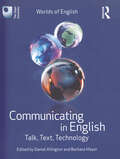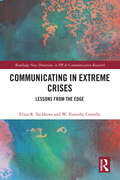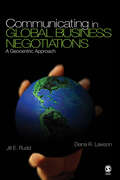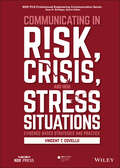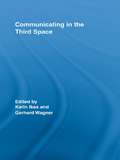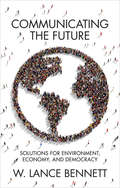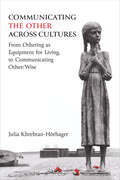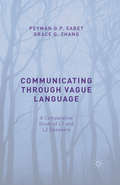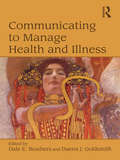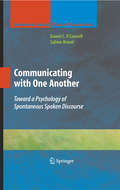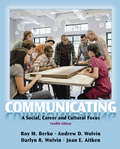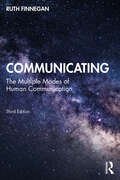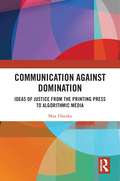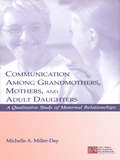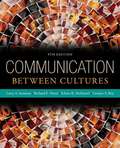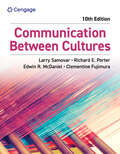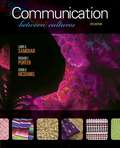- Table View
- List View
Communicating in English: Talk, Text, Technology
by Daniel Allington Barbara MayorCommunicating in English: Talk, Text, Technology looks at how people use spoken and written English to communicate in their everyday lives. Exploring the complex relationship between communication, technology and the English language, this book offers the reader practical insights into the analysis of speech and writing. A wide range of examples is provided, ranging from text messages and domestic quarrels to the works of Shakespeare and the words of Martin Luther King. This book takes a fresh look at established topics such as rhetoric, language acquisition, and professional communication, as well as covering exciting new fields such as everyday creativity, digital media, and the history of the book. Key theoretical concepts are introduced in an accessible manner, and the reader is given an in-depth understanding of English-language communication in its social and historical contexts. Drawing on the latest research and on the Open University’s experience of producing accessible and innovative texts, this book: • explains basic concepts and assumes no previous study of English studies, communication studies or linguistics • features a range of source material and commissioned readings to supplement chapters • includes contributions from leading experts in their fields, including Naomi Baron, Deborah Cameron, Guy Cook, Janet Holmes and Almut Koester • has a truly international scope, encompassing examples and case studies from Europe, North America, Africa, Asia, and Australasia • is illustrated in full colour and includes a comprehensive index. Communicating in English: Talk, Text, Technology is essential reading for all students of English language studies or communication studies.
Communicating in Extreme Crises: Lessons from the Edge (Routledge New Directions in PR & Communication Research)
by W. Timothy Coombs Elina TachkovaThis book is an evidence-based approach to handling common, extreme crises. Extreme crises involve strong moral outrage; moral outrage creates situations where traditional crisis communication advice no longer is effective. These extreme crises create unique demands for crisis managers. Moreover, much of the traditional advice and crisis key performance indicators (KPIs) no longer apply. Validated through research, the book establishes the nature of extreme crises, the optimal crisis response for such crises, and the KPIs (outcomes) crisis managers need to measure for extreme crises. It serves as a guide for how to communicate effectively during extreme crises and provides advice based upon experimental research that validates the effectiveness of the crisis communication interventions. Readers do not require prior knowledge about crisis communication and crisis management as the book contains summaries of crisis communication and management before exploring the more specialized topic of extreme crises. Chapters include extended case studies, examining communication within such events as the Westpac money laundering, VW emissions and COVID-19 crises. Communications in Extreme Crises will be of direct interest to scholars of crisis communication in public relations, corporate communication, strategic communication, organizational communication programs and management.
Communicating in Global Business Negotiations: A Geocentric Approach
by Jill E. Rudd Diana R. Lawson"Communication in Global Business Negotiations: A Geocentric Approach presents college-level business and communications majors with a new approach for studying communication and negotiation in international business, using a geocentric cross-disciplinary framework. Chapters cover intercultural communication, provide students with a view of the world and how to negotiate with others from different cultures, and uses practitioners′ perspectives to inject real-world case studies and scenarios into the picture. College-level business collections will find this an essential acquisition."—THE MIDWEST BOOK REVIEW"Authors Jill E. Rudd and Diana R. Lawson uniquely integrate communication and international business perspectives to help readers develop a strong understanding of the elements for negotiating an international setting, as well as the skills needed to adapt to the changing environment."—BUSINESS INDIAPresenting a new method for the study of communication and negotiation in international business, this text provides students with the knowledge to conduct negotiations from a geocentric framework. Authors Jill E. Rudd and Diana R. Lawson integrate communication and international business perspectives to help readers develop a strong understanding of the elements necessary for negotiating in a global setting, as well as the skills needed to adapt to the changing environment. This geocentric orientation is an evolution of global learning resulting in effective worldwide negotiation. Key Features:Offers a cross-disciplinary approach: The fields of communication and business are integrated to provide a macro-orientation to global business negotiation.Devotes a chapter to intercultural communication competency: Scales are included to help students assess their potential to become a successful global business negotiators.Provides students with a view of the world in negotiating with others from different cultures: Up-to-date information about current international business contexts gives insight into the challenges experienced by global business negotiators.Discusses alternative dispute resolution: Because of differences in culture and in political structure from one country to another, a chapter is devoted to this growing area of global business negotiation. Presents practitioners′ perspectives: These perspectives illustrate the "real world" of global business negotiation and reinforce the importance of understanding cultural differences.Intended Audience:This is an ideal core text for advanced undergraduate and graduate courses such as Negotiation & Conflict Resolution and International Business & Management in the departments of Communication and Business & Management.
Communicating in Risk, Crisis, and High Stress Situations: Evidence-Based Strategies and Practice (IEEE PCS Professional Engineering Communication Series)
by Vincent T. CovelloCOMMUNICATING IN R!SK, CRISIS, AND HIGH STRESS SITUATIONS LEARN THE UNIFYING PRINCIPLES BEHIND RISK, CRISIS, AND HIGH STRESS COMMUNICATION WITH THIS STATE-OF-THE-ART REFERENCE WRITTEN BY A MAJOR LEADER IN THE FIELD Communicating in Risk, Crisis, and High Stress Situations: Evidence-Based Strategies and Practice is about communicating with people in the most challenging circumstances: high stress situations characterized by high risks and high stakes. The ability to communicate effectively in a high stress situation is an essential communication competency for managers, engineers, scientists, and professionals in every field who can be thrust into demanding situations complicated by stress. Whether you are confronting an external crisis, an internal emergency, or leading organizational change, this book was written for you. Communicating in Risk, Crisis, and High Stress Situations brings together in one resource proven scientific research with practical, hands-on guidance from a world leader in the field. The book covers such critical topics as trust, stakeholder engagement, misinformation, messaging, and audience perceptions in the context of stress. This book is uniquely readable, thorough, and useful, thanks to features that include: Evidence-based theories and concepts that underlie and guide practice Tools and guidelines for practical and effective planning and application Experience-based advice for facing challenges posed by mainstream and social media Provocative case studies that bring home the key principles and strategies Illuminating case diaries that use the author’s breadth and depth of experience to create extraordinary learning opportunities The book is a necessity for managers, engineers, scientists, and others who must communicate difficult technical concepts to a concerned public. It also belongs on the bookshelves of leaders and communicators in public and private sector organizations looking for a one-stop reference and evidence-based practical guide for communicating effectively in emotionally charged situations. Written by a highly successful academic, consultant, and trainer, the book is also designed as a resource for training and education.
Communicating in the Third Space (Routledge Research in Cultural and Media Studies)
by Gerhard Wagner Karin IkasCommunicating in the Third Space aims to clarify Homi K. Bhabha’s theory of the third space of enunciation by reconstructing its philosophical, sociological, geographical, and political meaning with attention to the special advantages and ambiguities that arise as it is applied in practical--as well as theoretical--contexts. The idea of "third space" conceives the encounter of two distinct and unequal social groups as taking place in a special third space of enunciation where culture is disseminated and displaced from the interacting groups, making way for the invention of a hybrid identity, whereby these two groups conceive themselves to partake in a common identity relating to shared space and common dialogue. The essays collected in Communicating in the Third Space--including a preface by Bhabha himself--brilliantly introduce readers to this exciting topic in Cultural and Post-Colonial theory and offers insightful elaboration and critique of the meaning and relevance of life in the "third space." With a preface by Homi K. Bhabha.
Communicating the Future: Solutions for Environment, Economy and Democracy
by W. Lance BennettWe are facing an unprecedented environmental crisis. How can we communicate and act more effectively to make the political and economic changes required to survive and even thrive within the life-support capacities of our planet? This is the question at the heart of W. Lance Bennett’s much-anticipated book. Bennett challenges readers to consider how best to approach the environmental crisis by changing how we think about the relationships between environment, economy, and democracy. He introduces a framework that citizens, practitioners, and scholars can use to evaluate common but unproductive communication that blocks thinking about change; develop more effective ways to define and approach problems; and design communication processes to engage diverse publics and organizations in developing understandings, goals, and political strategies. Until advocates develop economic programs with built-in environmental solutions, they will continue to lose policy fights. Putting “intersectional” communication into action requires acknowledging that communication is not only an exchange of messages, but an organizational process. Communicating the Future is important reading for students and scholars of media and communication, as well as general readers concerned about the environmental crisis.
Communicating the Other across Cultures: From Othering as Equipment for Living, to Communicating Other/Wise
by Julia Khrebtan-HörhagerWhenever political and social decisions use categories of identity such as race, religion, social class, or nationality to distinguish groups of people, they risk holding certain groups as inferior and culturally “Other.” When people employ ideologies of imperialism, colonialism, patriarchy, and classism, they position certain groups as superior or ideal/ized people. Such ideological positioning causes nations to take actions that isolate or endanger minoritized populations. This cultural Othering can lead to atrocities such as Native Americans being expelled from their native lands through the Trail of Tears, millions of Ukrainians starving to death during the Holodomor, or millions of Jews exterminated during the Holocaust. Communicating the Other across Cultures uses examples from the United States, Western Europe, and Russia to demonstrate historical patterns of Othering people, as well as how marginalized people fight back against dominant powers that seek to silence or erase them. Deeply ingrained in our society, cultural Othering affects information in history books, children’s education, and the values upheld in our society. By taking a closer look at historical and modern instances of Othering, Julia Khrebtan-Hörhager shows examples of how different societies created ideas of social and cultural superiority or inferiority, and how deeply they are ingrained in our current society. In everyday life—the cash in your pocket, the movies shown at your local theater, museum exhibits, or politician's speeches—certain cultural ideologies are consistently upheld, while others are silenced. By exposing the communicative patterns of those in power, Khrebtan-Hörhager then suggests alternative ways of thinking, communicating, and eventually being, that offer transformative solutions for global problems.
Communicating through Vague Language: A Comparative Study of L1 and L2 Speakers
by Grace Q. Zhang Peyman G.P. SabetThis book is a comparative study of vague language based on naturally occurring data of L1 and L2 speakers in academic settings. It explores how L2 learners have diverse and culturally specific needs for vague language compared with L1s, and are generally vaguer.
Communicating to Manage Health and Illness
by Dale E. Brashers Daena GoldsmithCommunicating to Manage Health and Illness is a valuable resource for those in the field of health and interpersonal communication, public health, medicine, and related health disciplines. This scholarly edited volume advances the theoretical bases of health communication in two key areas: 1) communication, identity, and relationships; and 2) health care provider patient interaction. Chapters aim to underscore the theory that communication processes are a link between personal, social, cultural, and institutional factors and various facets of health and illness. Contributors to the work are respected scholars from the fields of communication, public health, medicine nursing, psychology, and other areas, and focus on ways in which patient identity is communicated in health-related interactions. This book serves as an excellent reference tool and is a substantial addition to health communication literature.
Communicating with Asia
by Gerhard LeitnerCommunicating with Asia brings together an international team of leading researchers to discuss South, South-East, East and Central Asia, and explore Mandarin, Cantonese, Hindi-Urdu, Malay, and Russian as major languages. The volume locates English inside a number of national, regional or lingua franca contexts and illustrates the way it develops in such contact situations. Local dynamics affecting languages in contact and cultural links of languages are dealt with, such as educational-political issues and tensions between conflicting norms. In today's global world, where the continent is an increasing area of focus, it is vital to explore what it means to 'understand' Asian cultures through English and other languages. This important new study will be of interest to students and researchers working in the fields of regional studies, English as a global language, Asian languages and cultural studies.
Communicating with Children
by Rachel FearnleyWhen a parent is nearing the end of life, children can feel like their world has been turned upside down, and they are often scared and confused about what is happening. Sensitive and clear communication with children is vital to help them understand and cope with their parent's illness. This accessible book demonstrates how to support children through effective and sensitive communication, covering types of communication, language, information sharing, and overcoming common barriers. Developing confidence and skills such as talking, listening, giving children a voice and breaking bad news is also covered. The author outlines the concept of a 'communication continuum' which can be used to assess how much a child knows or understands about their parent's illness and how much they would like to know. The book contains a wealth of practical strategies and ideas, as well as case vignettes, practice tips and reflective exercises. This is an essential resource for anyone working with or supporting a child whose parent is at the end of life, including palliative care workers, nurses, social workers, teachers and counsellors.
Communicating with One Another: Toward a Psychology of Spontaneous Spoken Discourse (Cognition and Language: A Series in Psycholinguistics)
by Sabine KowalIn contrast to traditional approaches of mainstream psycholinguists, the authors of Communicating with One Another approach spontaneous spoken discourse as a dynamic process, rich with structures, patterns, and rules other than conventional grammar and syntax. Daniel C. O'Connell and Sabine Kowal thoroughly critique mainstream psycholinguistics, proposing instead a shift in theoretical focus from experimentation to field observation, from monologue to dialogue, and from the written to the spoken. They invoke four theoretical principles: intersubjectivity, perspectivity, open-endedness, and verbal integrity. Their analyses of historical and original research raise significant questions about the relationship between spoken and written discourse, particularly with regard to transcription and punctuation. With emphasis on political discourse, media interviews, and dramatic performance, the authors review both familiar and unexplored characteristics of spontaneous spoken communication, including: (1) The speaker's use of prosody. (2) The functions of interjections. (3) What fillers do for a living. (4) Turn-taking: Smooth and otherwise. (5) Laughter, applause, and booing: from individual listener to collective audience. (6) Pauses, silence, and the art of listening. The paradigm shift proposed in Communicating with One Another will interest and provoke readers concerned about communicative language use - including psycholinguists, sociolinguists, and anthropological linguists.
Communicating: A Social, Career, and Cultural Focus (Mycommunicationlab Ser.)
by Andrew Wolvin Darlyn R. Wolvin Roy Berko Joan E. AitkenThis highly-regarded introduction to communication book offers a comprehensive blend of basic communication theory, research, and skills, with a strong emphasis on relationship communication (social), workplace (career), and intercultural communication (culture). Communicating introduces the basic principles of communication and applies them to interpersonal, group, interviewing, and public speaking contexts. The book stresses communication competence through boxed material, Learn by Doing activities, thought-provoking questions, and self-assessment tests. New and strengthened pedagogy highlights and reinforces the book's social, career, and cultural themes, with a particular emphasis on intercultural communication and communicating in an increasingly high-tech, global environment.
Communicating: The Multiple Modes of Human Communication
by Ruth FinneganMany accounts of human communication suggest that we are limited to communicating through words, visual images, the mass media and by digital means. This perspective underestimates the multisensory qualities of much of our human interconnecting and the multiple sounds, touches, sights and material objects which humans use so creatively to interconnect both nearby and across space and time. Ruth Finnegan brings together research from linguistic and sensory anthropology, alternative approaches to 'material culture' and 'the body', non-verbal communication, cultural studies, computer-mediated communication, and illuminating work on animal communication. Examples from both western and non-western cultures together with plentiful illustrations enrich and deepen the analysis. The book uncovers the amazing array of sounds, sights, smells, gestures, looks, movements, touches and material objects which humans use so creatively to interconnect both nearby and across space and time - resources consistently underestimated in those western ideologies that prioritise 'rationality' and referential language. Focussing on embodied and material processes, and on practice rather than text, this comparative analysis challenges the underlying cognitive and word-centred model common to many approaches to communication. The second edition of Communicating includes a new introduction, updates to take account of recent work, an additional chapter covering ethereal non-verbal non-bodily communicating such as telepathy and dreams, fresh illustrations, a new conclusion and updated bibliography. This authoritative but accessible book is an essential transdisciplinary overview for researchers and advanced students in language and communication, anthropology and cultural studies.
Communicating: The Multiple Modes of Human Communication
by Ruth FinneganTreatments of human communication mostly draw on cognitive and word-centred models to present it as predominantly a matter of words. This, Finnegan argues, seriously underestimates the far-reaching multi-modal qualities of human interconnecting and the senses of touch, olfaction, and, above all, audition and vision that we draw on. In an authoritative and readable account, Ruth Finnegan brings together research from linguistic and sensory anthropology, material culture, non-verbal communication, computer-mediated communication, and, strikingly, research on animal communication, such as the remarkable gesture systems of great apes. She draws on her background in classical studies and her long anthropological experience to present illuminating examples from throughout the world, past and present. The result is to uncover an amazing array of sounds, sights, smells, gestures, looks, movements, touches, and material objects used by humans and other animals to interconnect both nearby and across space and time She goes on to first explore the extra-sensory modes of communication now being revealed in the extraordinary "new science" research and then, in an incendiary conclusion, to deny the long-prevailing story of human history by questioning whether orality really came before literacy; whether it was really through "the acquisition of language" that our prehistoric cave painting ancestors made a sudden leap into being "true humans"; and finally, astonishingly, to ask whether human communicating had its first roots not, after all, in verbal language but something else. Not to be missed, this highly original book brings a fresh perspective on, among other things, that central topic of interest today – the dawn of human history – and on what being homo sapiens really means. This revised and updated edition has additional illustrations, updated chapters, and a new concluding chapter. A provocative and controversial account that will stir worldwide debate, this book is an essential transdisciplinary overview for researchers and advanced students in language and communication, anthropology, and cultural studies.
Communication Accommodation Theory
by Howard GilesMost people modify their ways of speaking, writing, texting, and e-mailing, and so on, according to the people with whom they are communicating. This fascinating book asks why we 'accommodate' to others in this way, and explores the various social consequences arising from it. Communication Accommodation Theory (CAT), revised and elaborated over the past 40 years, has been applied to a wide range of situations, from families to courtrooms, and from media to hospitals, by means of diverse methodologies in many disciplines, and across numerous languages and cultures. Bringing together a team of experts, this book demonstrates how the theory can help us towards a greater understanding of interpersonal communication in a multitude of contexts. Finally, it examines the principles of the theory, identifying a range of avenues along which research can move forward in future.
Communication Across Cultures
by Heather Bowe Kylie MartinCommunication Across Cultures is an academic reference for university students and interdisciplinary researchers who have no specialised knowledge of linguistics. Key concepts relevant to an understanding of language issues in intercultural communication are drawn from the research area of pragmatics, discourse analysis, politeness and cross cultural communication. The book examines the ways in which the spoken and written word may be interpreted differently depending on the context and expectations of the participants. Intercultural communication involves additional sociocultural dimensions to the context. Examples are drawn from a variety of languages and cultures - ranging from Japan to Germany to the Americas, to Africa and to Australia. Relevant academic literature and recent research is exemplified and explained throughout the book so readers can become familiar with the way research in this field is conducted and so that interdisciplinary researchers can incorporate some of the perspectives presented here into their own research.
Communication Across Cultures
by Heather Bowe Kylie Martin Heather Bowe Kylie Martin Howard MannsCommunication Across Cultures explores how cultural context affects the use and (mis)interpretation of language. It provides an accessible and interdisciplinary introduction to language and language variation in intercultural communication by drawing on both classic and cutting-edge research from pragmatics, discourse analysis, sociolinguistics, linguistic anthropology and politeness studies. This new edition has been comprehensively updated to incorporate recent research, with an emphasis on the fluid and emergent practice of intercultural communication. It provides increased coverage of variation in language within and between cultures, drawing on real-world examples of spoken and written communication. The authors review classic concepts like 'face', 'politeness' and 'speech acts', but also critique these concepts and introduce more recent approaches. Each chapter provides a set of suggested readings, questions and exercises to enable the student to work through concepts and consolidate their understanding of intercultural communication. This is an excellent resource for students of linguistics and related disciplines.
Communication Activities for the Classroom: Embodied Pedagogy Across the Communication Curriculum (Palgrave Practical Guides in Communication)
by Lyndsay Michalik Gratch Ariel Gratch Andrea BaldwinThis book contains over 20 activities for use in the in-person communication studies classroom. Communication is an embodied act: our thoughts, ideas, and messages originate in our body and through our experiences. An embodied approach to pedagogy fosters inclusivity, creativity, and critical thinking, making classrooms more dynamic and equitable spaces. Drawing on a wide range of performance studies-based approaches and theories, the activities in this book can be applied across the communication studies curriculum, including relational communication, organizational communication, media studies, public address, and communication and culture. Whether you are hesitant to incorporate performance in your classroom or you regularly invite your students to &“get up and play,&” the activities in this book provide a step-by-step guide that is accessible to all communication teachers.
Communication Against Domination: Ideas of Justice from the Printing Press to Algorithmic Media
by Max HänskaThis book tackles the philosophical challenge of bridging the gap between empirical research into communication and information technology, and normative questions of justice and how we ought to communicate with each other. It brings the question of what justice demands of communication to the center of social science research. Max Hänska undertakes expansive philosophical analysis to locate the proper place of normativity in social science research, a looming subject in light of the sweeping roles of information technologies in our social world today. The book’s first section examines metatheoretical issues to provide a framework for normative analysis, while the second applies this framework to three technological epochs: broadcast communication, the Internet and networked communications, and the increasing integration of artificial intelligence and machine learning technologies into our communication systems. Hänska goes beyond the prevailing frameworks in the field by exploring how we answer normative questions and how our answer can change depending on our social context and the affordances of prevailing communications technologies. This book provides an essential guide for scholars as well as graduate and advanced undergraduate students of research and theory in communication, philosophy, political science, and the social sciences.
Communication Among Grandmothers, Mothers, and Adult Daughters: A Qualitative Study of Maternal Relationships (LEA's Series on Personal Relationships)
by Michelle A. Miller-DayThis volume examines communication processes within the grandmother-mother-daughter relationship, emphasizing an intergenerational perspective. Using observations of and extensive interviews with six sets of middle-income, Caucasian female family members, this book offers a heuristic account of intergenerational mother-daughter relational communication.Author Michelle Miller-Day integrates and juxtaposes alternative experiences of social interaction, situating readers in the world of grandmothers, mothers, adult daughters, and granddaughters as they experience, describe, and analyze their family communication. Miller-Day incorporates aged mothers and younger mid-life mothers and their adult daughters into the research to illustrate how this type of maternal relationship is experienced at different points in a woman's life. With the inclusion of three generations of women, Miller-Day offers multigenerational perspectives on family, and examines them for patterns of maternal interaction, providing symbolic links across generational boundaries.Communication Among Grandmothers, Mothers, and Adult Daughters enables readers to understand more completely the richly textured nature of maternal relationships. It will be an invaluable resource for scholars and researchers in the areas of communication and relationships, including family communication, intergenerational communication, women's studies, family studies, interpersonal communication, and relationships, as well as social workers, psychologists, and counselors, who strive to understand family communication processes and their dynamics across generational lines.
Communication And The Natural World
by Judith HendryCommunication and the Natural World introduces students to the complex issues and arguments that pervade current discourse about the environment. The book explores the ways our communication profoundly affects how we perceive and interact with the natural world. And it shows, clearly and vividly, how cultural, philosophical, commercial, mass-mediated, and popular discourse shape social as well as environmental policy. Thoroughly updated to reflect current theoretical perspectives, recent events and controversies, and evolving issues and concerns, the second edition also has a heightened emphasis on digital citizen activism, environmental justice, and the challenges arising from the erosion of trust in science and media.
Communication Between Cultures
by Richard E. Porter Larry A. Samovar Edwin R. McDaniel Carolyn Sexton RoyEmphasizing the roles that family, religion, and history play in intercultural communication, COMMUNICATION BETWEEN CULTURES, 9E helps you increase your understanding and appreciation of different cultures while developing practical skills for improving your communication with people from other cultures. Bringing chapter concepts to life, the text is packed with the latest research and compelling examples that help you take a look at your own assumptions, perceptions, and cultural biases so you can see the subtle and profound ways culture affects communication. The ninth edition also includes insightful discussions of the impact of globalization, a new chapter on intercultural communication competence, and extensive coverage of new technology.
Communication Between Cultures
by Richard E. Porter Larry A. Samovar Edwin R. McDaniel Clementine K. FujimuraWith its incorporation and representation of diverse perspectives, Samovar/Porter/McDaniel’s COMMUNICATION BETWEEN CULTURES, 10th Edition, helps students increase their understanding of the importance of cultural understanding for successful intercultural interactions. Packed with the latest research and compelling examples, this edition helps students look at their own assumptions, perceptions and cultural biases so they can see the subtle and profound ways culture affects communication. The 10th Edition addresses the importance of intercultural communication in the context of current global and technological and is accessible to all students, inclusive in its writing and personalization of activities.
Communication Between Cultures (Eighth Edition)
by Richard E. Porter Larry A. Samovar Edwin R. Mcdaniel Carolyn S. RoyThis intercultural communication text gives readers an understanding and appreciation of different cultures and helps them develop practical skills for improving their communication with people from other cultures.
